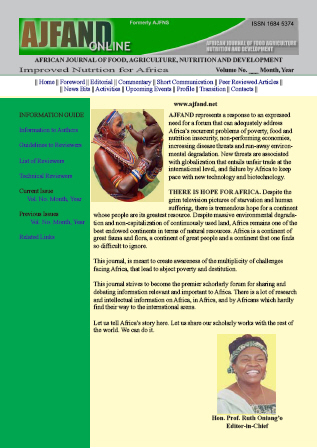
|
African Journal of Food, Agriculture, Nutrition and Development
Rural Outreach Program
ISSN: 1684-5358
EISSN: 1684-5358
Vol. 8, No. 1, 2008, pp. 17-27
|
 Bioline Code: nd08004
Bioline Code: nd08004
Full paper language: English
Document type: Research Article
Document available free of charge
|
|
|
African Journal of Food, Agriculture, Nutrition and Development, Vol. 8, No. 1, 2008, pp. 17-27
| en |
Chemical and Sensory Quality of Omaze Uozongombe (ghee), Butter Oil Made by Small Holder Herero Farmers In Namibia
Bille, P. G. & Kandjou, M. J.
Abstract
This study was conducted to determine the quality of Omaze Uozongombe, a traditional Herero community Ghee in Namibia in order to improve it for commercial purposes. Ghee is not well known and not found in the formal market in Namibia, except from the Herero community who live their lives around cattle in the rural Namibia. The traditional ghee is made from fermented milk that has been incubated for 2-3 days at ambient temperatures in a seeded calabash containing roots of Omunkunzi (Boscia albitrunca) tree in order to speed up the fermentation process, add flavour and to assist in the churning process. The resulting fermented milk is churned by shaking the calabash for 1-2 hours to obtain butter. The butter is scooped off, washed, boiled and clarified into a golden yellow product (Ghee). The Ghee is then packed in recycled metal or plastic containers. Traditional ghee in Namibia is characterized by short shelf life, high moisture and sediment contents, rancid taste and oxidized flavour. Samples of traditional and laboratory made ghee were analyzed for physico-chemical and sensory characteristics for quality comparison, extension of shelf-life and for improving its palatability, acceptability and marketing. The results showed that there was no significant difference (p<0.05) between the traditional and laboratory made ghee in terms of sediments or filth. However, the traditional ghee samples showed a higher mean percentage of free fatty acids (1.56%) with rancid flavour, higher mean peroxide value (17mEq/kg) or oxidized flavour and significantly higher mean moisture content (0.46%). As a result, laboratory processed ghee was given a higher grade in sensory scores by a panel of judges and was considered superior. Improvement of traditional ghee processing parameters and quality properties are necessary, using good manufacturing practices on unit operation. In addition, proper packaging of ghee in containers injected with inert gases such as nitrogen and addition of antioxidants for storage and distribution in the Namibian and neighboring markets will be an advantage.
Keywords
Ghee, peroxide values, sensory quality
|
| |
© Copyright 2008 -Rural Outreach Program
Alternative site location: http://www.ajfand.net/
|
|
